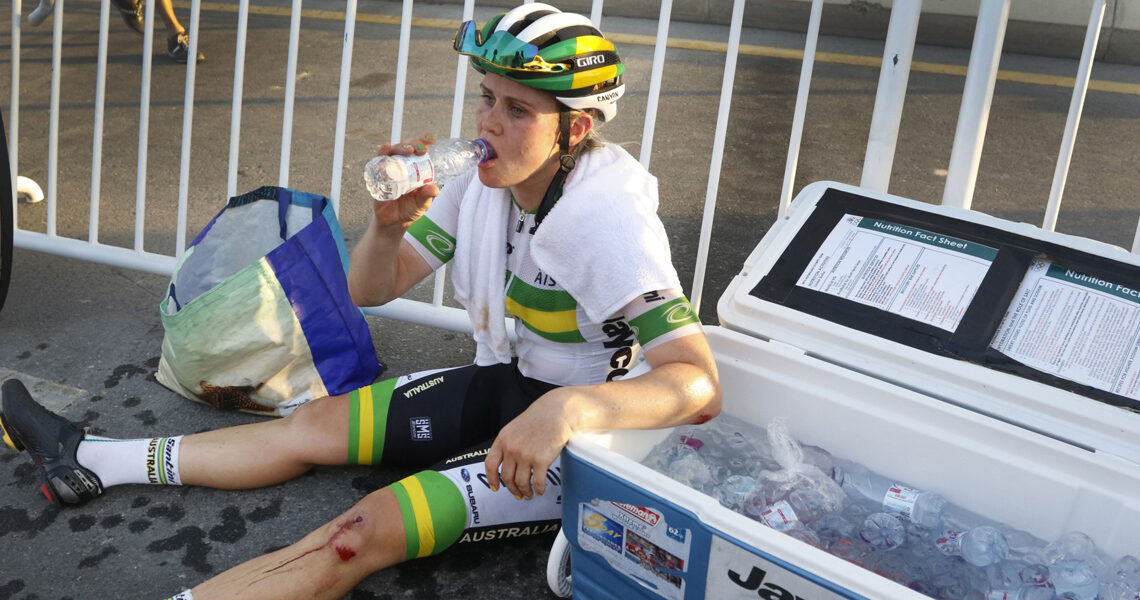
Dehydration is one of the biggest threats to peak cycling performance—especially in hot and humid conditions. But what if you could delay its effects before your ride even begins? Enter hyperhydration: a science-backed strategy designed to increase your body’s fluid reserves before you hit the saddle. By combining sodium, glycerol, or both, hyperhydration can expand plasma volume, reduce core temperature, and extend endurance. Whether you’re training in extreme heat or racing without frequent access to fluids, this technique could be the performance edge you’ve been missing.
We all know the negative impact that being dehydrated can have on performance. If dehydration is bad, then one potential may be to start hyperhydrated to delay dehydration? Here’s a closer look at the science, use applications, and best practices.

Heat training is growing in popularity among pro riders and amateur cyclists alike. While many athletes are familiar with the benefits of heat adaptation, like lower core temperature and increased sweat efficiency, few are aware of a complementary strategy: hyperhydration. This method can provide similar physiological advantages and may give you an edge when the temperature starts to drift up.
What Is Hyperhydration?
Hyperhydration refers to increasing total body water before exercise. By doing so, athletes can tolerate a greater fluid loss before performance begins to decline. However, if you’re able to maintain hydration during exercise (by keeping fluid loss under 2% of body weight), hyperhydration won’t offer much extra benefit. It’s most useful when the risk of dehydration is high—during long, hot races or when fluid access is limited (1).
The benefits of hyperhydration overlap with those of heat training, including:
- Expanded blood plasma volume
- Lower heart rate
- Reduced core temperature
- Increased time to exhaustion
To hyperhydrate effectively, athletes typically ingest sodium and/or glycerol with large amounts of fluid. These substances help the body retain more water than it would by drinking water alone. Normally, the kidneys regulate excess fluid by increasing urine output, but glycerol and sodium slow this process, allowing more water to “stick” in the body (1).
Glycerol: A Resurging Option
Glycerol is a three-carbon alcohol naturally found in some foods like soybeans and often added to processed products as a sweetener or thickener. It’s easily absorbed and distributed throughout the body. Once absorbed, glycerol concentrates near kidney cells, limiting how much fluid is filtered out through urine. This means your body retains more water, and the effect lasts for several hours, longer than plain water alone (2).
Between 2010 and 2018, glycerol was banned by WADA due to concerns it could mask blood doping by increasing plasma volume. However, it was later removed from the banned list after studies showed minimal impact on blood markers like hemoglobin and hematocrit. During its time on the list, sodium rose in popularity as a primary hyperhydration strategy.
How to Use Glycerol
Glycerol is typically sold as food-grade vegetable glycerin—a thick, clear liquid. To use it:
- Mix 1.0–1.2 g/kg body weight of glycerol with 20–25 ml/kg of fluid
- Consume over a 60-minute period, two hours before exercise, which allows time to urinate any excess fluid.
Results typically show around 39% fluid retention—about 500 ml of the 1,800 ml consumed by a 70 kg athlete (3,4).
Sodium: The More Option
Sodium also creates an osmotic effect like glycerol, but it has additional power: it stimulates hormones like antidiuretic hormone (ADH) and aldosterone, which further promote water reabsorption in the kidneys. In studies, sodium consistently outperforms glycerol for fluid retention, though both are significantly more effective than water alone.
How to Use Sodium
- Drink 20–25 ml/kg of body weight in fluid
- Include 3 grams of sodium per liter (equivalent to about 7.5 g of salt)
This approach results in roughly 60% fluid retention, or 1,100 ml of the 1,800 ml needed for a 70 kg athlete (3,4).

Combining Sodium and Glycerol
Recent research has shown that combining sodium and glycerol has additive effects. In one study, fluid retention reached 77% when both were used, compared to 60% for sodium alone and 39% for glycerol alone (4).
There’s also growing interest in sodium bicarbonate, commonly used to buffer lactic acid during high-intensity exercise. Because it requires large sodium and fluid doses, it may double as a hyperhydration tool. One study found that sodium bicarbonate increased plasma volume by 8.1%, compared to 5.9% from sodium citrate and a decrease in a control group (5). This suggests a novel dual benefit: buffering and hyperhydrating at once.
Evidence of Performance Benefits
A recent systematic review on hyperhydration strategies using sodium and glycerol confirmed that both are effective in increasing total body water. Whether this translates into a performance benefit, however, depends on the context.
- 5 of 7 studies reported a significant increase in time to exhaustion
- 9 studies found a reduction in heart rate by 3–11 bpm during steady work
- Plasma volume increased by 6–9%
- Skin temperature also dropped when plasma volume rose
These changes suggest that hyperhydration may help athletes maintain performance in the heat by reducing cardiovascular strain and improving thermoregulation.
When to Use Hyperhydration
Hyperhydration isn’t for every ride or every rider. It may not help (and could even hinder) performance in cooler conditions or hilly courses where extra water weight is a disadvantage. However, it shines in specific scenarios:
- When fluid needs exceed what you can realistically drink. Example: Sweating out 1.8 L/hr requires drinking 1.3 L/hr over 4 hours—not easy.
- Training or racing in high heat or humidity
- Limited fluid access, such as remote courses or long gaps between aid stations
- Back-to-back race days or training sessions
- Restricted in-race drinking, such as in time trials or weight-class sports
- Poor thirst cues or low drive to drink during exercise
- Evening races where post-event hydration may disrupt sleep
Think of it like carb-loading for hydration: just as topping up glycogen stores helps delay energy depletion, hyperhydration helps delay dehydration.
Cautions of Hyperhydration
Hyperhydration isn’t risk-free. Some athletes may experience GI distress, nausea, or diarrhea. And of course, added body weight from retained fluids may be a disadvantage depending on the course profile. Like any nutrition or performance strategy, it should be tested in training before race day.
Hyperhydration may not be mainstream, but it’s a well-supported strategy with clear physiological benefits when used appropriately. For cyclists tackling long, hot, or logistically challenging events, it could be the key to staying cool, strong, and ahead of the peloton.

References
- Jardine, W. T., Aisbett, B., Kelly, M. K., Burke, L. M., Ross, M. L., Condo, D., Périard, J. D., & Carr, A. J. (2023). The Effect of Pre-Exercise Hyperhydration on Exercise Performance, Physiological Outcomes and Gastrointestinal Symptoms: A Systematic Review. Sports medicine (Auckland, N.Z.), 53(11), 2111–2134. https://doi.org/10.1007/s40279-023-01885-2
- Goulet, E. D., Aubertin-Leheudre, M., Plante, G. E., & Dionne, I. J. (2007). A meta-analysis of the effects of glycerol-induced hyperhydration on fluid retention and endurance performance. International journal of sport nutrition and exercise metabolism, 17(4), 391–410. https://doi.org/10.1123/ijsnem.17.4.391
- Savoie, F. A., Dion, T., Asselin, A., & Goulet, E. D. (2015). Sodium-induced hyperhydration decreases urine output and improves fluid balance compared with glycerol- and water-induced hyperhydration. Applied physiology, nutrition, and metabolism = Physiologie appliquee, nutrition et metabolisme, 40(1), 51–58. https://doi.org/10.1139/apnm-2014-0243
- Goulet, E. D. B., De La Flore, A., Savoie, F. A., & Gosselin, J. (2018). Salt + Glycerol-Induced Hyperhydration Enhances Fluid Retention More Than Salt- or Glycerol-Induced Hyperhydration. International journal of sport nutrition and exercise metabolism, 28(3), 246–252. https://doi.org/10.1123/ijsnem.2017-0310
- Siegler, J. C., Carr, A. J., Jardine, W. T., Convit, L., Cross, R., Chapman, D., Burke, L. M., & Ross, M. (2022). The Hyperhydration Potential of Sodium Bicarbonate and Sodium Citrate. International Journal of Sport Nutrition and Exercise Metabolism, 32(2), 74-81. Retrieved Jul 29, 2025, from https://doi.org/10.1123/ijsnem.2021-0179
The post Hyperhydration for Cyclists: Science-Backed Strategy to Boost Performance in the Heat appeared first on PezCycling News.




